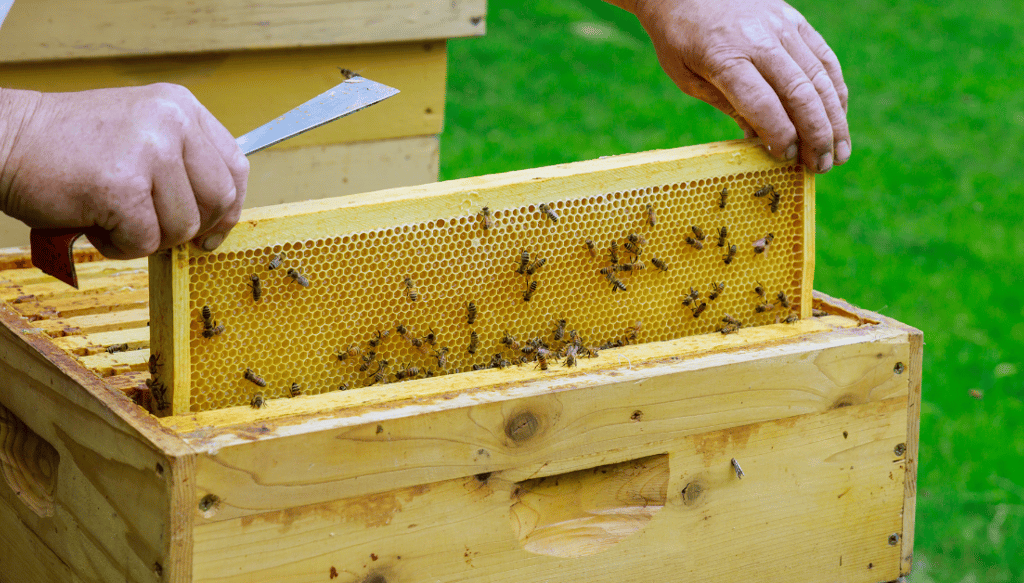Why Foundation is Used in Beehive Frames: A Comprehensive Guide
Discover why foundation is essential in beehive frames. Learn how foundation guides comb-building, improves hive management, enhances durability, and supports bee health. Ideal for both beginner and experienced beekeepers.


Beekeeping is an ancient practice, but modern innovations have helped make it more efficient and sustainable. One of these innovations is the use of foundation in beehive frames. This component is a crucial part of beekeeping that can significantly impact the health and productivity of a colony. But what exactly is foundation, and why is it used in beehive frames?
In this blog post, we will explore what foundation is, the different types available, why it's used, and how it benefits both bees and beekeepers. Whether you're a beginner or a seasoned beekeeper, understanding the role of foundation can help you better manage your hives.
What Is Foundation in Beehive Frames?
Foundation is a thin sheet, typically made of beeswax or plastic, that is inserted into the frames of a beehive. The purpose of the foundation is to provide a base or "template" upon which bees can build their wax comb.
The foundation has hexagonal patterns imprinted on it that mimic the natural structure of honeycomb. When bees are provided with this template, they can construct their comb faster and more efficiently, allowing them to focus on other essential tasks like brood rearing, honey storage, and pollen collection.
Types of Foundation
There are two main types of foundation used in beehive frames:
Beeswax Foundation: Made from natural beeswax, this type is widely favored because it closely resembles the bees' natural environment. It can be purchased pre-formed with hexagonal cell patterns or can be handmade by beekeepers who melt and press their beeswax.
Plastic Foundation: This type of foundation is made from food-grade plastic and often comes with a wax coating to make it more attractive to the bees. It's durable, reusable, and easier to clean, but some beekeepers feel that bees don't take to plastic foundation as naturally as they do to beeswax.
Why Use Foundation in Beehive Frames?
1. Helps Guide the Comb-Building Process
In the wild, bees build comb in various patterns that may not always be straight or aligned with the beekeeper’s hive structure. The use of foundation provides bees with a structured guide to build their comb in a more organized manner. This ensures the comb fits perfectly within the frame, making it easier for beekeepers to manage the hive and harvest honey.
2. Improves Hive Management
Foundation helps make hive management easier and more efficient. With a well-structured comb, beekeepers can easily inspect the brood, manage hive pests, and harvest honey without damaging the comb. Additionally, by encouraging bees to build in the center of the frame, foundation helps avoid irregular or cross-combing, which can lead to hive disruption.
3. Increases Comb Durability
Foundation, especially plastic foundation, adds a level of durability to the comb that helps it withstand repeated handling. Beeswax comb is delicate and can easily be damaged during inspections or honey extractions. By reinforcing the comb with foundation, it becomes more stable, reducing the likelihood of comb collapse or breakage.
4. Encourages Faster Comb Building
One of the key reasons beekeepers use foundation is to speed up the comb-building process. When bees are given a foundation, they don’t have to spend as much time building the initial hexagonal cell structure. Instead, they can focus on expanding the comb and using it for brood rearing and honey storage, which is particularly beneficial during periods of high nectar flow.
5. Supports Brood Rearing and Honey Storage
Bees use the comb to raise their young (brood) and store honey and pollen. By providing bees with foundation, beekeepers ensure that there is ample room for both brood and honey in the hive. A well-structured comb with a consistent pattern is critical for a healthy and productive colony.
6. Helps Control Varroa Mite Infestation
Varroa mites are one of the most serious threats to honeybee colonies. These parasites reproduce in the brood cells, particularly in drone comb. Some beekeepers use foundation to control the size and placement of drone comb, limiting the space available for mites to reproduce. This method, known as drone comb management, is a natural way to help mitigate mite infestations without the use of chemicals.
Pros and Cons of Different Foundation Types
Beeswax Foundation
Pros:
Bees accept it more readily because it mimics natural comb.
Made from natural materials.
Biodegradable and eco-friendly.
Cons:
Fragile and prone to breaking during handling.
Can be expensive.
Requires periodic replacement as it can become contaminated with pesticides or disease.
Plastic Foundation
Pros:
Durable and long-lasting.
Can be reused, reducing the need for frequent replacements.
Easy to clean and maintain.
Cons:
Bees may take longer to start building on plastic.
Not biodegradable.
Some beekeepers believe it disrupts the natural environment of the hive.
How to Install Foundation in Beehive Frames
The process of installing foundation in beehive frames is relatively simple, but it requires attention to detail to ensure that the foundation is properly secured and ready for the bees to use.
Steps to Install Foundation:
Prepare the Frames: Ensure the beehive frames are clean and free of debris. If you're using wired frames, the wires should be tightened so that they can hold the foundation securely.
Insert the Foundation: Gently slide the foundation into the frame, ensuring that it fits snugly. In the case of plastic foundation, you may need to snap it into place.
Secure the Foundation: If using beeswax foundation, you'll need to secure it using wire or pins. For plastic foundation, this step may not be necessary as most plastic foundations are designed to lock into the frame.
Place in the Hive: Once the foundation is installed in the frames, they can be placed into the hive. The bees will begin building comb on the foundation almost immediately, especially during times of nectar flow.
Alternatives to Using Foundation
While foundation is a valuable tool in beekeeping, it is not the only option. Some beekeepers prefer a more natural approach and use foundationless frames, allowing bees to build comb without any artificial guides. In this method, a simple starter strip of wax or wood is used to encourage bees to build straight comb.
Advantages of Foundationless Frames:
Allows bees to build comb more naturally.
Eliminates concerns about contamination from commercial wax or plastics.
May reduce the risk of spreading disease through contaminated wax.
Disadvantages of Foundationless Frames:
Bees may build irregular or cross-combed structures.
Comb is more fragile and prone to damage.
May require more frequent inspections to ensure proper comb alignment.
Conclusion:
Foundation plays a critical role in modern beekeeping, offering both practical and structural benefits to bees and beekeepers. By guiding bees to build their comb in an organized manner, foundation helps improve hive management, increase productivity, and enhance colony health. Whether you choose beeswax or plastic foundation, or even opt for foundationless frames, understanding the role of foundation in beehive frames is key to successful and sustainable beekeeping.
With a well-structured hive, your bees can focus on what they do best—producing honey, raising brood, and pollinating plants—ensuring a thriving colony and a productive apiary.


